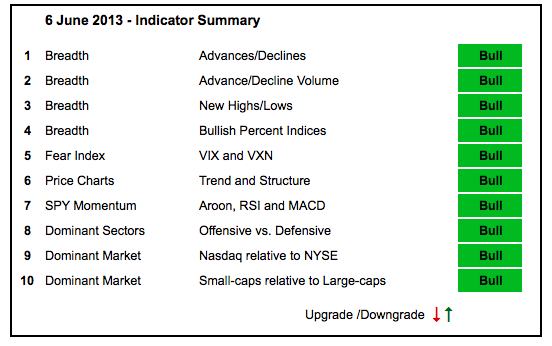The market is hitting its first make-or-break point. The bulk of the evidence remains bullish and this decline is still considered a correction within a bigger uptrend. The current decline, however, has extended long enough to push some indicators to the brink though. NYSE Net New Highs have been flirting with negative numbers as interest rate sensitive issues hit new lows. SPY momentum is at a key point as RSI moved into the 40-50 zone, which marks support in an uptrend. The S&P 500 Volatility Index ($VIX) bounced the last 2-3 weeks and is near its resistance zone. After the big advances from mid November to mid May, the market is certainly entitled to a corrective period.


- AD Lines: Bullish. The Nasdaq and NYSE AD Lines pulled back over the last few weeks, but remain in long-term uptrends.
- AD Volume Lines: Bullish. The Nasdaq and NYSE AD Volume Lines also pulled back, but remain in long-term uptrends.
- Net New Highs: Bullish. NYSE Net New Highs turned negative the past week and the cumulative line flattened. Nasdaq Net New Highs are still positive, but have fallen from their recent highs.
- Bullish Percent Indices: Bullish. All nine BPIs are above 50%.
- VIX/VXN: Bullish. The S&P 500 Volatility Index ($VIX) and the Nasdaq 100 Volatility Index ($VXN) moved higher the last 2-3 weeks, but remain below resistance from their February-April highs (±20).
- Trend-Structure: Bullish. DIA, IWM, MDY, QQQ and SPY hit 52-week highs in May and corrected the last 2-3 weeks. The short-term trends may be down, but the medium and long-term trends are still up.
- SPY Momentum: Bullish. RSI declined to its support zone (40-50) and the Aroon Oscillator declined to -50. This is the make-or-break point for momentum. A break below 40 in RSI and -50 in Aroon would turn this group bearish.
- Offensive Sector Performance: Bullish. XLF, XLI, XLK and XLY led the market from mid April to mid May and hit 52-week highs. These four also held up better than the defensive sectors during the correction of the last 2-3 weeks.
- Nasdaq Performance: Bullish. The $COMPQ:$NYC ratio broke out in May and has been moving higher the last six weeks.
- Small-cap Performance: Bullish. The $RUT:$OEX ratio bottomed in mid April and broke out in May. Small-caps have been outperforming since early May.
- Breadth Charts (here) and Intermarket Charts (here) have been updated.
This table is designed to offer an objective look at current market conditions. It does not aim to pick tops or bottoms. Instead, it seeks to identify noticeable shifts in buying and selling pressure.
This commentary and charts-of-interest are designed to stimulate thinking. This analysis is
not a recommendation to buy, sell, hold or sell short any security (stock ETF or otherwise).
We all need to think for ourselves when it comes to trading our own accounts. First, it is
the only way to really learn. Second, we are the only ones responsible for our decisions.
Think of these charts as food for further analysis. Before making a trade, it is important
to have a plan. Plan the trade and trade the plan. Among other things, this includes setting
a trigger level, a target area and a stop-loss level. It is also important to plan for three
possible price movements: advance, decline or sideways. Have a plan for all three scenarios
BEFORE making the trade. Consider possible holding times. And finally, look at overall market
conditions and sector/industry performance.

About the author:
Arthur Hill, CMT, is the Chief Technical Strategist at TrendInvestorPro.com. Focusing predominantly on US equities and ETFs, his systematic approach of identifying trend, finding signals within the trend, and setting key price levels has made him an esteemed market technician. Arthur has written articles for numerous financial publications including Barrons and Stocks & Commodities Magazine. In addition to his Chartered Market Technician (CMT) designation, he holds an MBA from the Cass Business School at City University in London.
Learn More





